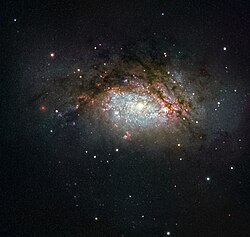Elliptical galaxy
An elliptical galaxy is a galaxy having an ellipsoidal shape, and a smooth, nearly featureless brightness profile. They are one of the three main types of galaxy originally described by Edwin Hubble in 1936.[1] The others are spiral and lenticular galaxies.
Elliptical galaxies range in shape from nearly spherical to nearly flat, (E7, one of the flattest types of elliptical galaxies is cigar-shaped) and in size from hundreds of millions to over one trillion stars. Originally, Edwin Hubble thought that elliptical galaxies may evolve into spiral galaxies, but this turned out to be false.[2] Stars found inside elliptical galaxies are much older (and cooler; thus redder) than stars found in spiral galaxies.[2]
Most elliptical galaxies are composed of older, low-mass stars, with a sparse interstellar medium and minimal (or no)star formation activity. They tend to be surrounded by large numbers of globular clusters. Elliptical galaxies are believed to make up approximately 10–15% of galaxies in the Virgo Supercluster, but are not the dominant type of galaxy in the universe overall.[3] They are usually found close to the centers of galaxy clusters.[4]
Elliptical galaxies and lenticular galaxies are also called "early-type" galaxies (ETG), due to their position in the Hubble sequence. They are less common in the early Universe, that is, in galaxies further away from us.[5]
Elliptical Galaxy Media
Elliptical galaxy IC 2006
The galaxy located in the image is 4C 73.08, a giant elliptical galaxy.
Hercules A, a supergiant elliptical galaxy and also a radio galaxy. The radio lobes shown here in pink are over a million light-years across.
The brilliant central object is the supergiant elliptical galaxy SDSS J142347.87+240442.4, the dominant member of the galaxy cluster MACS J1423.8+2404. It has a diameter of 380,000 light-years. Note the gravitational lensing.
NGC 3597 is the product of a collision between two galaxies. It is evolving into a giant elliptical galaxy.
Related pages
- IC 1101: the largest known galaxy in the cluster Abell 2029
- Messier 87-Famous Galaxy in the Virgo Cluster, known for its unusual plasma jet.
- Messier 49-Bright Galaxy in the Virgo Cluster.
- Messier 59 -Found nearby Messier 60, another galaxy in the Virgo cluster.
- Abell-2261 BCG -Has one of the largest cores of any Galaxy a.
References
- ↑ Hubble, E.P. (1936). The realm of the nebulae. New Haven: Yale University Press. ISBN 0-300-02500-9.
- ↑ Loveday J. (February 1996). "The APM Bright Galaxy Catalogue". Monthly Notices of the Royal Astronomical Society. 278 (4): 1025–1048. arXiv:astro-ph/9603040. Bibcode:1996MNRAS.278.1025L. doi:10.1093/mnras/278.4.1025.
- ↑ Dressler A. (March 1980). "Galaxy morphology in rich clusters - Implications for the formation and evolution of galaxies". The Astrophysical Journal. 236: 351–365. Bibcode:1980ApJ...236..351D. doi:10.1086/157753.
- ↑ We see the furthest galaxies as they were at an earlier stage in the universe.





